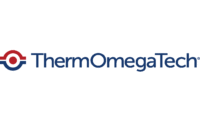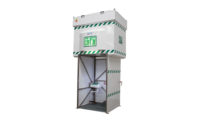Quickly attaining the correct water temperature, pressure and flow rate are all critical factors in helping to make sure affected users will drench long enough — at least 15 minutes — to remove all hazardous chemicals from affected areas. Therefore, selecting the right tankless water heater or thermostatic mixing valve (TMV) — two of the most common solutions for supplying tepid water — will help ensure optimal performance and proper usage of emergency equipment.
Why tepid water?
ANSI Z358.1-2009 requires the use of tepid flushing fluid for all types of emergency equipment applications. Tepid water is defined in the standard as a flushing fluid that is at a temperature conducive to encouraging an injured party to complete the full 15-minute flush during an emergency. ANSI suggests an incoming water temperature between 60°F and 100°F.
Although the ANSI requirement has been in place since 1998, maintaining tepid water is often left unheeded. Largely due to time and cost, some incorrectly expect that cold water will be sufficient for eyewash or drench shower fixtures, but the flushing fluid needs to be delivered at a comfortable lukewarm temperature that is not harmful to the user. If the water is too cold — or too hot — the user is much less likely to withstand the full 15-minute flush. Moreover, if the water is below 60°F, prolonged exposure can affect the body’s ability to maintain its body temperature, increasing the risk of hypothermia. If the fluid delivered to the affected user is over 100°F, it’s possible that the hot water could exacerbate a chemical interaction with the eyes and skin. It’s clear that a dependable delivery system of on-demand and unlimited tepid water is vital in relieving affected users of hazardous chemicals and materials from their eyes and/or body.
Water pressure and flow
It’s also essential for every potential hazard at a worksite to be supported by a plumbed or portable device that has access to an adequate water supply at an appropriate pressure and temperature. It’s important that the amount of water supplied to the unit can adequately support a full 15-minute flow of flushing fluid. Therefore, a minimum water pressure of 30 pounds per square inch (PSI) should be supplied to emergency drench showers and eyewashes.
The water supply must also satisfy the ANSI minimum flow rate, which is at least 20 gallons per minute (GPM) for drench showers, 0.4 GPM for eyewashes and 3.0 GPM for eye and face washes. Because different products have varying flow rates, it’s important to confirm flow rates with the equipment manufacturer.
In certain instances, supplemental products can provide a source of quick, immediate relief, but they cannot replace the more crucial need for a full 15-minute rinse with tepid water.
Tepid water delivery systems
Tankless water heaters and emergency thermostatic mixing valves (TMVs) are both effective solutions for delivering tepid water consistently and reliably to emergency fixtures. Both technologies help ensure that the user will stay in the water rinse for the full 15 minutes. However, not all systems are created equally. Following are some key product features to consider when selecting a system:
Electric Tankless Water Heaters. Newer tankless water heating systems are highly efficient solutions for providing an unlimited supply of tepid water for use in eyewash and drench shower systems. These models draw energy only when needed, reach the ANSI standards for tepid water temperatures in 20 to 30 seconds, hold outlet temperature to within ± 1°F, and have a low pressure drop (as low as 8 pounds per square inch). These features minimize potential post-installation complications that could be caused by a sudden decrease in pressure.
Some newer water heaters are designed with redundant safety and anti-scald features to meet ANSI tepid water requirements. They also provide overshoot purge protection that will automatically open to purge excess hot water whenever necessary.
Because today’s tankless water heaters draw energy only when needed, they can provide great operational efficiency and lower energy expenses. In addition to energy savings, installation is easy because only one electrical connection and a cold water line are needed, saving labor time and additional expenses.
Rightsizing tankless water heaters is critical, as there are many variables that affect the correct sizing, such as flow rate, temperature rise and the available power supply. When calculating temperature rise, it’s important to base this from the annual coldest ground water temperature. Be sure to carefully review the products technical data to select the right sized heater for the application.
TMVs. With TMVs, the hot and cold water is brought into the valve where it is mixed together and then routed over an internal thermal element called a thermostat. The thermostat continuously maintains the temperature of the mixed water flowing through the TMV. If the temperature differs from the valve’s set temperature, the thermostat will react and move a mechanism that modulates one or both of the inlet ports until the valve returns to the set temperature, thus ensuring that each emergency fixture is provided with tepid water.
It is important to use TMVs designed specifically for supplying tepid water to emergency fixtures — as opposed to standard thermostatic mixing valves — because they feature a cold water bypass. Should the thermostat fail or the valve lose its hot water source for any reason, the cold water would still be allowed to flow through the valve to the emergency fixture. If the cold supply is lost, the valve will shut off and prevent the hot water from flowing through the valve to the emergency fixture. This protects the user from the potential dangers of a hot flushing fluid being supplied to the eyewash or shower.
Finding the right tepid water delivery system for emergency fixtures may seem daunting but consulting with a safety consultant or an emergency equipment product manufacturer can help develop the best strategy based on the needs of specific work environments.




